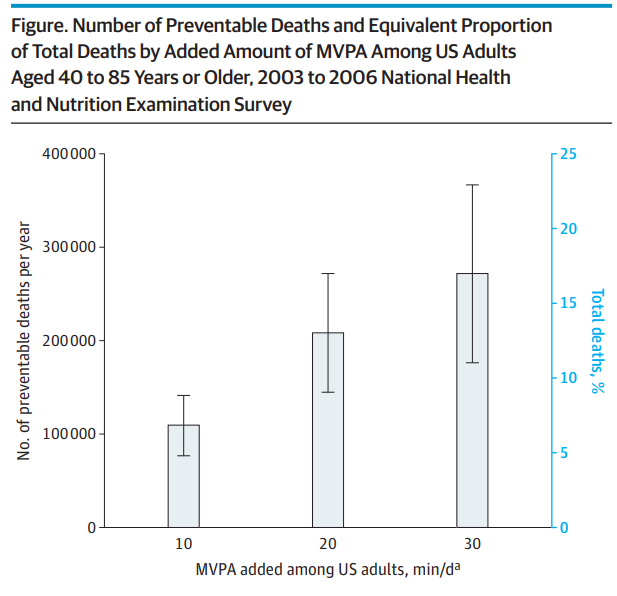The Worst Mistake Patients Make After Concussion Recovery: Staying Active is Key!
One of the most common questions I get after someone clears their Buffalo Concussion Treadmill Test is, "Can I keep exercising?" It baffles me that this question even arises, but my answer is always a resounding yes!
The real issue is that many people, particularly non-athletes who don't have a sport or competition to train for, stop moving once they're cleared. This is actually one of the worst things you can do for your overall health.
As a concussion specialist who’s worked with hundreds of people each year—from professional athletes to non-athletes—I’ve seen firsthand how staying active can be a game-changer for long-term recovery and overall health.
In this blog, I’ll explain why stopping exercise after you're cleared from a concussion is one of the biggest mistakes you can make, and how staying active can dramatically reduce your risk of various diseases and even death.
The Dangers of Stopping Exercise
After a concussion, movement is essential for recovery during the initial stages. However, once cleared, many people stop exercising altogether. This isn't just bad for your brain health; it's detrimental for your body as well. We're biologically designed to move—our bodies have bones, joints, muscles, lungs, and hearts for a reason!
Studies show that about 50% of our waking hours are spent sedentary, and less than one in four U.S. adults gets the recommended 300 minutes of activity per week. We're talking about purposeful activity—not just exercise, but simply moving around.
This lack of movement can increase your risk of heart disease, cancer, metabolic disease, and even early death.
How Much Exercise Do You Really Need?
This is where the magic number of 150 minutes comes into play. The CDC, World Health Organization, American Heart Association, and many other organizations recommend 150 minutes of moderate activity per week or 75 minutes of vigorous activity per week. But what does that look like?
Moderate Activity: Activities like brisk walking, light cycling, or water aerobics where you’re definitely exercising but can still hold a conversation. This typically falls into a heart rate zone of about 65-75% of your maximum heart rate.
Vigorous Activity: This includes running, swimming, or high-intensity workouts where you're breathing hard and can only get out a few words. This is typically above 80-85% of your maximum heart rate.
If you're not ready for 150 minutes a week, start small. Something is better than nothing! A 2022 JAMA study found that adding just 10 minutes a day of movement could prevent 110,000 deaths annually in the U.S. If we bump that to 20 minutes a day, we could reduce deaths by 133%!
Replacing Sitting with Movement
What if we replaced one hour of sitting with walking? If we did that, we could reduce all-cause mortality by 22%. If we swapped one hour of sitting with vigorous activity, the reduction could be a whopping 31%! This means that just a little movement can make a massive difference in your health.
(Don’t believe it’s that simple? Check out the jargon below.)
Stamatakis, E., Gale, J., Bauman, A., Ekelund, U., Hamer, M., & Ding, D. (2019). Sitting time, physical activity, and risk of mortality in adults. Journal of the American College of Cardiology, 73(16), 2062-2072.
How to Make Exercise a Habit
So, after a concussion, how do you make movement a regular part of your life?
First, don’t view exercise as a punishment.
Embrace the mindset that you get to exercise! Challenge yourself to see how fast you can run or how high you can jump. Set simple goals, such as aiming for 22 minutes of moderate activity daily.
If that feels overwhelming, aim for just 10 minutes! Remember, tracking your steps can motivate you; aim for 6,000 to 10,000 steps daily. There’s no upper limit on the benefits of movement—more steps equal better health!
Have Fun with Movement
Lastly, choose activities you enjoy! Whether it's walking, dancing, swimming, or even martial arts, find something that makes you feel good. Movement doesn't have to be perfect; it just has to happen!
Final Thoughts: Movement is Non-Negotiable
The biggest mistake you can make after being cleared from a concussion is thinking your recovery ends there. Stopping exercise isn’t just a missed opportunity—it’s a setback for your long-term health. But the good news? Even small steps make a difference.
Here are the key takeaways:
Stopping exercise post-concussion is risky: It can negatively impact both your brain and overall health.
Small steps matter: Even 10 minutes of daily movement can improve health and lower disease risk.
Consistency is key: Aim for at least 150 minutes of moderate weekly exercise.
Replace sitting with movement: Swapping sedentary time for activity can reduce your risk of early death.
Make it fun: Choose activities you enjoy to make movement a sustainable habit.
Incorporating these into your daily routine can boost recovery, improve performance, and enhance long-term health.
If this blog gave you clarity or motivation, share it with someone who could benefit from it.
For more tips on optimizing recovery and performance, check out my posts on leveraging omega-3s for athletic performance and what we know about repetitive head impacts. Thanks for reading, and remember to stay active, stay healthy, and stay in control of your recovery!
Take the Next Step Toward Lasting Health
If you’re recovering from a concussion, looking to regain your fitness, or want personalized advice on how to make exercise work, I’d love to help. At my clinic, we take a comprehensive, evidence-based approach to concussion recovery, long-term brain health, and injury prevention, tailored to your unique needs.
Don’t wait for questions to go unanswered or for inactivity to set you back. Book an intro call today, and let’s create a plan to keep you moving, feeling better, and performing at your best.

